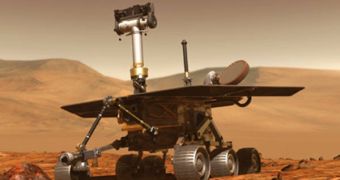Over the past few weeks, Spirit has been making its way to the Goddard and Von Braun features, having departed the “Home Plate” plateau, where it spent the rugged Martian winter. Looking back with its cameras, the robotic probe took snapshots of its own trails, sending back images that took NASA by surprise. They reveal two bright patches of soil that have been churned up by Spirit's small wheels. The tracks were generated by the robot's front wheel, which has been damaged since 2006.
Currently, the probe is driving backwards, as it finds it impossible to move head-on in any direction, on account of the fact that the jammed front wheel would make any such attempt fail. However, it has proven to be very useful even in its current state, as it has uncovered the mysterious bright soil underneath the planet's red sands on other occasions.
A subsequent analysis of the soil has revealed that its color comes from high concentrations of sulfur and silica, which have been used to establish the fact that water, indeed, has flown over the place Spirit is driving through now.
The tracks were made during the 1,861st sol (Martian day), which translates into March 28th in Earth days. The length of the trail surprised even the rover mission experts at NASA, who immediately decided to use the craft's instruments to analyze the chemical composition of the soil. Space reports that the alpha particle X-ray spectrometer has been assigned for the task and that the results of the study should be made available shortly.
NASA's five-year-old rover is currently faced with another problem, this time one of navigation. Its path over the known Martian soil is obstructed by piles of loose rocks. These formations are very dangerous to the small robot, so mission managers have decided to take the long way around. This would, indeed, lengthen the amount of time it would otherwise have taken for the robot to get to its summery destination, but officials at NASA say that, at this point, Spirit's safety comes first, and that they are unwilling to take any chances.
“Spirit could not make progress in the last two attempts to get up onto Home Plate. Alternatively, we are driving Spirit around Home Plate to the east. Spirit will have to go around a couple of small ridges that extend to the northeast, and then see whether a route east of Home Plate looks traversable. If that route proves not to be traversable, a route around the west side of Home Plate is still an option,” Mars Exploration Rovers' Project Manager John Callas, who is also a scientist at NASA's JPL facility, in Greenbelt, Maryland, explains.

 14 DAY TRIAL //
14 DAY TRIAL //